In this week’s eSkeptic:

NEW ON MICHAELSHERMER.COM
Globaloney: Why the Earth is Not Flat…Yet
In the August Skeptic column from Scientific American, Michael Shermer reminds us that many experts believe that a global economy may be unattainable because of our evolved tribal natures. However, according to Pankaj Ghemawat, author of World 3.0: Global Prosperity and How to Achieve It, that notion is all a bunch of “globaloney.”

Interview with Bill Nye “the Science Guy”
It’s safe to say that a generation of science enthusiasts were inspired by and knowledgeable about the wonders of life on earth (and beyond) by the man best known as Bill Nye “the Science Guy”. In recent years, William Nye’s concern about our changing planet has garnered him new monikers, like Bill Nye “the Climate Guy”, and as Executive Director of The Plantary Society, Bill Nye “the Planetary Guy”.
This week on Skepticality, Derek & Swoopy talk with “that guy”, William Nye (who recently was a featured guest at The James Randi Educational Foundation’s 2011 Amazing Meeting 9), about the challenges facing a new generation of science educators on television and in the classroom. They also discuss his new project that promotes literacy in algebra entitled “Solving for X.”
About this week’s feature article
In this week’s eSkeptic (the first part in a two-part series), we present an article from Skeptic magazine’ (volume 1, number 3) in which Michael Shermer investigates an extraordinary claim regarding proof of ESP made by the Edgar Cayce Association for Research and Enlightenment (A.R.E.). In their study, two classic (but extremely common) blunders were committed: (1) misinterpreting statistical results, and (2) ignoring a basic tenet of scientific testing—repeatability.
Tune in next week for the response from the A.R.E. and Michael Shermer’s reply.
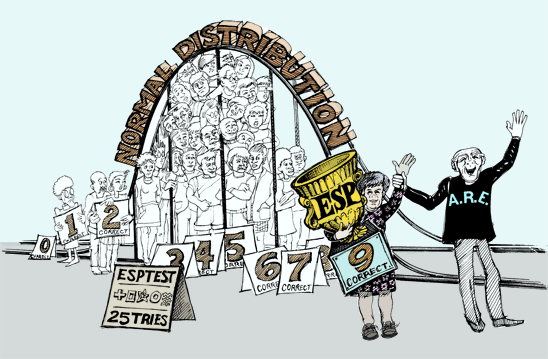
Deviations
A Skeptical Investigation of Edgar Cayce’s Association for Research and Enlightenment
by Michael Shermer
One of the most overused one-liners in the statistical business is Disraeli’s classification of lies into the three taxa of “lies, damn lies, and statistics.” Unfortunately it is sometimes true, as the recent presidential election will attest. George Bush and Bill Clinton tossed out mind-numbing numbers about the opposition’s failures and their own successes, while Ross Perot waved his voodoo stick over dozens of charts, graphs, and curves. But if statistics are nothing but lies, then what good are they as a scientific tool? The answer is that the tool itself is not deceitful. The presentation of some statistics and not others to slant one’s position—a lie of omission not commission—is a common abuse, but this in itself does not negate the process.
The problem really lies in the general misunderstanding of statistics that is part of the larger “innumeracy”— or mathematical illiteracy—of the population. I saw a classic example of this in an investigation by the Skeptics Society of Edgar Cayce’s Association for Research and Enlightenment (A.R.E.), located in Virginia Beach, Virginia (Box 595, 23451). The investigation—a brief visit, a simple experiment, and an explanation that was not well received— came about when Skeptic advisory board member Dr. Clay Drees, a professor of history at nearby Wesleyan College, and I decided to pay them a visit while I was in town on other business. We were fortunate to arrive on a relatively busy day during which they were conducting an “ESP Experiment.” Since they were claiming that one’s ESP could be tested experimentally and that the phenomenon could be proved scientifically, it was fair game for skeptics.”
According to their own literature, A.R.E. was “founded in 1931 to preserve, research, and make available the readings of Edgar Cayce.” Like many such organizations, A.R.E. has many of the trappings of science: a building the size and facade of which portrays modernity and authority; an extensive research library containing both the “readings” of Edgar Cayce and a fairly good science and pseudoscience collection; a book store with the full array of paranormal books, including those on “spiritual living,” “self-discovery,” “inner help,” “past lives,” and health, longevity, healing, “native wisdom,” and “the future;” and a stated purpose of itself as “a research organization” that “continues to index and catalogue the information, to initiate investigation and experiments, and to promote conferences, seminars, and lectures.”
The corpus of accepted beliefs, however, is anything but scientific, and reads like an A-to-Z what’s what of the paranormal. The “Circulating Files Index” of the library, for example, includes the following available selections of readings from Cayce: angels and archangels, astrological influences on earth experiences, economic healing, evaluating psychic talent, intuition, visions and dreams, Karma and the law of grace, magnetic healing, the missing years of Jesus, oneness of life and death, planetary sojourns and astrology, principles of psychic science, reincarnation, soul retrogression, and vibrations, to name just a few of the more than 14,000 readings on over 10,000 different subjects! A separate medical library contains its own “circulating files index” on every imaginable disease and its cure, and includes “Edgar Cayce’s famous ‘Black Book’” that will give you a “simple scar removal formula,” explain “the best hours of sleep,” tell you “the best exercise,” clarify what “will help the memory,” and, on page 209, solve that most mysterious of medical conundrums: “how to get rid of bad breath.”
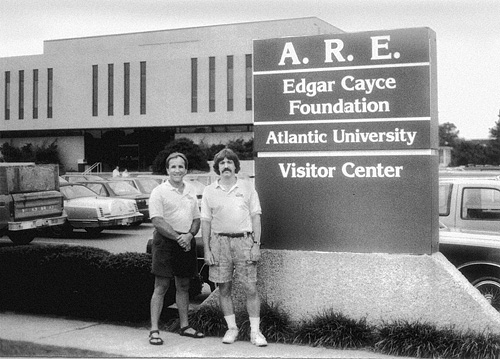
Skeptic editorial advisor Dr. Clay Drees and publisher Dr. Michael Shermer none the worse after a skeptical investigation of A.R.E.
To reinforce their beliefs in more traditional settings, A.R.E. has its own press—the A.R.E. Publishing Company—and incorporates the Atlantic University of Transpersonal Studies, an ”independent studies program” with a total of six courses, including: TS 501—Introduction to Transpersonal Studies (the works of Cayce, Maslow, Frankl, and Buddhism); TS 503—The Origin and Development of Human Consciousness (learn about ancient magicians, the great mother goddess), TS 504— Spiritual Philosophies and the Nature of Humanity (on spiritual creation and evolution), TS 506—The Inner Life: Dreams Meditation and Imaging (dreams as problem-solving tools), TS 508—Religious Traditions (Hinduism, Buddhism, Judaism, Islam and Christianity), and TS 518—Divination as a Way to Measure All (astrology, tarot, I Ching, handwriting analysis, palmistry and psychic readings).”
A potpourri of lectures and seminars reinforces belief in the believers and provides an opportunity for the uninitiated to get involved. A lecture on “Egypt, Myth, and Legend” by Ahmed Fayed has a not-so-hidden agenda: Edgar Cayce was once an Egyptian living in pharaonic Egypt. “Naming the Name: Choosing Jesus the Christ as Your Living Master,” demonstrates their openness to the more traditional religions and their lack of discrimination between any and all belief systems. A Southern California seminar on “Sounding and Overtone Chanting” will give you “tools for empowerment and transformation.” A three-day seminar on “The Healing Power of Past- Life Memories” features, among others, Raymond Moody, who demonstrates that the near-death experience is a bridge to the other side.
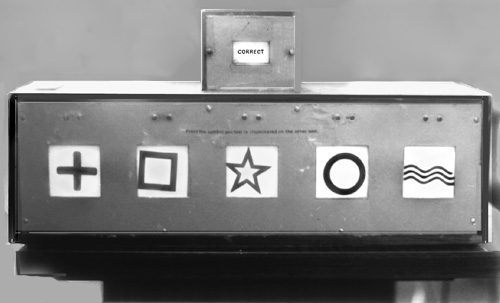
The most scientific piece of research equipment at A.R.E. was the ESP testing apparatus, complete with Zener cards, and lights and buttons for both sender and receiver.
Who was Edgar Cayce? Born in 1877 on a farm near Hopkinsville, Kentucky, Cayce, according to the A.R.E. literature, as a youth “displayed powers of perception which extended beyond the five senses. Eventually, he would become the most documented psychic of all times.” (One wonders if Mr. Geller would dispute the claim.) Purportedly when he was 21, Cayce’s doctors were unable to find a cause or cure for a “gradual paralysis which threatened the loss of his voice.” Cayce responded by going into a “hypnotic sleep” and recommended a cure for himself, which he claims worked. The discovery of his ability to diagnose illnesses and recommend solutions in an altered state led him to do this on a regular basis for others with medical problems. This, in turn, expanded into general psychic readings on thousands of different topics in every conceivable aspect of the universe, world, and man. It is these trance-like readings that constitute the bulk of the Cayce collection, which have been and continue to be catalogued, sorted, and indexed at A.R.E. ”
Numerous books have been written on Edgar Cayce, most of them by uncritical followers, such as Edgar Cayce—The Sleeping Prophet by Jess Stearn (1967) and Many Mansions: The Edgar Cayce Story on Reincarnation by Gina Cerminara, endorsed by Jeane Dixon (1967). Skeptical evaluations of Cayce have been provided by leading skeptics Martin Gardner and James Randi. Gardner (1957) demonstrates that from his youth Cayce was a fantasy-prone individual (see also Baker and Nickell’s 1992 analysis of his personality). He talked with angels and received visions of his dead grandfather, and, as he grew older, he got into the habit of reading the entire Bible at least once a year. An uneducated man beyond the ninth grade, Cayce acquired his broad scope of knowledge through voracious reading, and was from this able to weave elaborate tales and give detailed diagnoses in his trances. His early “readings” were done in the presence of an osteopath, from whom he borrowed much of his terminology. “The condition in the body is quite different from what we have had before…from the head, pains along through the body from the second, fifth and sixth dorsals, and from the first and second lumbar…tie-ups here, and floating lesions, or lateral lesions, in the muscular and nerve fibers…,” reads a diagnosis of his wife who had tuberculosis. As Gardner explains, “This is talk which makes sense to an osteopath, and to almost no one else” (p. 217).”
In Cayce, James Randi (1982) sees all the old familiar tricks of the psychic trade: “Cayce was fond of expressions like ‘I feel that…’ and ‘perhaps’—qualifying words used to avoid positive declarations” (p.189). Cayce’s remedies read like a list from a medieval herbalist: For a leg sore take oil of smoke; for a baby with convulsions, a peach-tree poultice; for dropsy, bedbug juice; for arthritis, peanut oil massage; and for his wife’s tuberculosis, ash from the wood of a bamboo tree. The important question, of course, is did they work? Randi has done a fairly extensive analysis of Cayce’s “cures” and concludes that “the matter is hard to prove, either way.” Testimony of a few patients does not represent a controlled experiment, while “dead patients cannot complain, and those who were not cured would benefit little by writing a letter of complaint.” Some of his more obvious failures include several readings on patients who had died between the time the letter to Cayce was written and when he made the reading. In one instance, he did a reading on a small girl who had died on a Sunday, but he did the reading on the subsequent Monday, suggesting a complex nutritional program to cure the disease, followed by the admonition: “And this depends upon whether one of the things as intended to be done today is done or isn’t done, see? Randi examines case after case and concludes that “the matter of Edgar Cayce boils down to a vague mass of garbled data, interpreted by true believers who have a very heavy stake in the acceptance of the claims” (pp. 189–195).”
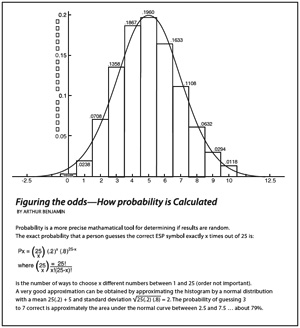
Click the diagram to download a larger PDF version.
“As politely as I could I raised my hand and asked: ‘If 3 to 7 is chance, and anything above 7 is evidence of ESP, what about someone who scores below a 3?’ The instructor responded: ‘That’s a sign of negative ESP.’”
PROBABILITY predicts these test results for a test of 25 questions with five possible answers if chance is operating:
Most people (79%) will get between 3 and 7 correct (probability is a more precise calculation).
The probability of guessing 8 or more correctly is 10.9% (in a group of 25, you can always expect several scores in this range purely by chance.)
The chances of getting 15 correct is about 1 in 90,000.
Guessing 20 out of 25 has a probability of about 1 in 5 billion.
Guessing all 25 correct has a chance of (.2) = 3.3 x 10, or about 1 in 300 quadrillion! (A wager against such an unusual occurrence would be a safe bet.)
It was, then, with considerable anticipation that we entered the halls of Edgar Cayce’s legacy through the entrance that bore the following inscription above the door: “THAT WE MAY MAKE MANIFEST THE LOVE OF GOD AND MAN.” The people who greeted us were very warm and friendly, though a tour of the facilities offered no enlightenment on their research. There were no laboratory rooms and virtually no scientific equipment, save an ESP machine proudly on display against a wall in the entrance hall. A large sign next to the machine announced that there would be an ESP experiment coming up in an adjacent room. We saw our opportunity to put some of their claims to the test.”
The ESP machine featured the standard Zener cards (created by K. E. Zener) with a button to push for each of the five symbols—a plus sign, square, star, circle, and wavy lines. It was wheeled into the room where one of the directors of A.R.E. first gave a lecture on ESP, Edgar Cayce, and the development of psychic powers. He explained that some people are born with a psychic gift while others need practice. But, he insisted, we all have the power to some degree. Experience is the key. He then asked for volunteers to be sender or receiver. I raised my hand and elected to receive. I was given no instruction on how to receive psychic messages, so I asked. The instructor explained that I should concentrate on the sender’s forehead. The rest of the people in the room, 34 of them, were told to do the same thing. We were all given an ESP Testing Score Sheet (my own presented below), with one column for our “guesses” (I cannot honestly call it anything else) and one column for the correct answers, given after the experiment. We ran two experiments of 25 trials each. I got 7 right in the first set, for which I honestly tried to “receive” the message, and 3 right in the second set, for which I put the plus sign for every answer.”
The instructor explained that “5 is average, chance is between 3 and 7, and that anything above 7 is evidence of ESP.”
As politely as I could I raised my hand and asked: “If 3 to 7 is chance, and anything above 7 is evidence of ESP, what about someone who scores below a 3?” The instructor responded: “That’s a sign of negative ESP.” (Whatever that is.)
I asked the group, “how many people in the first set got below 3?” Three people raised their hands and all said they got 2.
Another show of hands from the audience on their performance “above chance” revealed that in the first set three got 8, and in the second set one even got 9 out of the 25. So I did not have the power, but clearly at least four other people did. Or did they?”
Before Assuming that the high scores are due to ESP ability you first have to know what kind of scores people would get purely by chance— in a situation where ESP could not be operating. Suppose the five possible answers were fished out of a bowl by a monkey, or suppose the five answers were randomly generated by a computer, or suppose a receiver’s answers from a previous test were applied to a new batch of selections by a sender. In these cases the kind of scores expected by chance can be predicted by the science of statistics. Scientists use comparisons between statistically predicted test results and actual test results to determine if their results are “significant”—something more than what would be expected by chance. The ESP test results clearly matched the expected pattern for random results.” I explained as nicely as I could, “three got 2, and three got 8 and everyone else scored between 3 and 7. In the second set there was one 9, two 2s, and one 1, all different people from those who scored high and low in the first test! Doesn’t that sound like a normal distribution around an average of 5?”
The instructor turned to me and said, with a smile: “Are you an engineer or one of those statisticians or something?” The group laughed and he went back to lecturing about how to improve your ESP with practice. Then he asked for questions, so I waited until no one else had any and inquired: “You say you’ve been working with A.R.E. for several decades, correct?” He nodded affirmatively. “And you say that with experience one can improve ESP, right?” He immediately saw where I was going and said, ”Well…,” at which point I jumped in and drew the conclusion, “By now you must be very good at this sort of test. How about we send the signals to you at the machine. I’ll bet you could get at least 15 out of the 25.” He was not amused at my suggestion and explained to the group that he had not practiced ESP in a long time and besides, we were out of time for the experiment. He quickly dismissed the group, and a handful of people surrounded me and asked for an explanation of what I meant by “a normal distribution around an average of five.” “In a group this size,” I explained, “we should not put any special significance on the fact that someone might get 8 or so correct, or someone might score only one or two hits—it’s exactly what is expected to happen—by chance. (My colleague Art Benjamin explains the exact probabilities in the sidebar above.)”
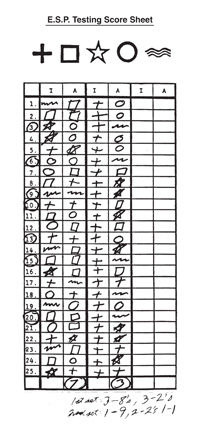
The ESP Testing Score Sheet: The Skeptic’s Score Sheet proves that skepticism blocks psychic power (click image to enlarge).
Instead of being proof of ESP, as these folks were claiming, these test results suggested that nothing other than chance was operating. Statistics do not lie. The deviation from the mean that this experiment revealed was nothing more than what we would expect under these conditions with these parameters. If the audience were expanded into the millions through a medium like television there would be an even bigger chance for misinterpretation of the high end scores. In this scenario a tiny fraction would fall at 3 standard deviations above the mean, or get 11 hits, a still smaller percentage would reach 4 standard deviations, or 13 hits, and so on, all by chance and the randomness of such large numbers. For psychics, the psychology of statistics is that you take the most deviant subject (in this statistical sense) and tout him as the proof of the power. For skeptics, the science of statistics tells us that by chance, and given a large enough group, there should be someone who will score fairly high. There may be lies and damned lies, but statistics can reveal the truth when murky pseudoscience is being espoused to an unsuspecting group.
P.S. One woman followed me out of the room and said (I am not making this up): “You’re one of those skeptics, aren’t you?” “I am indeed,” I responded. “Well then,” she retorted, “how do you explain coincidences like when I go to the phone to call my friend and she calls me? Isn’t that an example of psychic communication?”
“No it is not. It is an example of statistical coincidences. Let me ask you this. How many times did you go to the phone to call your friend and she did not call? Or how many times did your friend call you but you did not call her first? Or, or, or…as Aristotle said, ‘the sum of the coincidences equals certainty’.” She said she would have to think about it and get back to me. Later in the tour she found me and said she had figured it out: “I only remember the times that these events happen, and forget all those others you suggested.”
“Bingo!” I exclaimed, thinking I had a convert on my hands. “You got it. It is just selective perception.” But I was too optimistic. “No, this just proves that psychic power works sometimes but not others.” I am afraid I cannot improve upon Randi’s quip about belief in the paranormal being like an “unsinkable rubber duck”.![]()
Bibliography
- Baker, R.A. and J. Nickell. 1992. Missing Pieces: How to Investigate Ghosts, UFOs, Psychics, & Other Mysteries. Buffalo: Prometheus.
- Cerminara, G. 1967. Many Mansions: The Edgar Cayce Story on Reincarnation. New York: Signet.
- Gardner, M. 1952. Fads and Fallacies in the Name of Science. New York: Dover.
- Randi, J. 1982. Flim Flam! Psychics, ESP, Unicorns and other Delusions Buffalo: Prometheus Books.
- Stearn, J. 1967. Edgar Cayce—The Sleeping Prophet. New York: Bantam
Skeptical perspectives on psychics, ESP and other delusions…
-
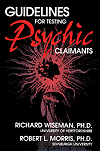 Guidelines for Testing Psychic Claimants
Guidelines for Testing Psychic Claimants
by Richard Wiseman and Robert L. Morris
-
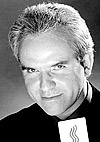 Mind Power: Fact, Fiction and Fakery
Mind Power: Fact, Fiction and Fakery
by Ian Rowland
-
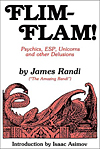 Flim Flam! Psychics, ESP, Unicorns
Flim Flam! Psychics, ESP, Unicorns
and other Delusions
by James Randi









